#miles okazaki
Text

Takashi Okazaki - Miles Morales
24 notes
·
View notes
Note
top 5 characters
OF ALL TIME? FROM ALL MEDIA? JESUS CHRIST TIA
uhmm..
I can't put them in order,. but
hisoka. eridan homed stuck. taako taaco. yuki sohma. and of course. keith voltron.
ps I want you to know it took me over an hour of intense thinking to come up with this list and I'm still not entirely happy with it
thank you for the pain!
edit 6/18/23 taking eridan off the list replacing him with vash the stampede
#this was unbelievably difficult ill have you know#special shoutouts to daryl dixon yusuke kitagawa kyle broflovski the 11th doctor cove holden allan melville mammon from obey me#lorenz hellman gloucester qifrey L lawliet dave & dirk strider mayoi ayase josuke higashikata haruto from project perfectly normal#ford from story of seasons trio of towns vyn richter shuichi saito from uzumaki byakuya togami tomoya okazaki kanji tatsumi reigen arataka#mikoto mikoshiba kamui gakupo shinji ikari shigeo kageyama todoroki shouto zuko from atla alhaitham kaeya alberich miles edgworth#clear from dmmd sebastian michaelis keiji shinogi mozu sheppard#if i repeated any names no i didnt <3#keithposting#10/25/23 eta sam & dean winchester#;
18 notes
·
View notes
Text
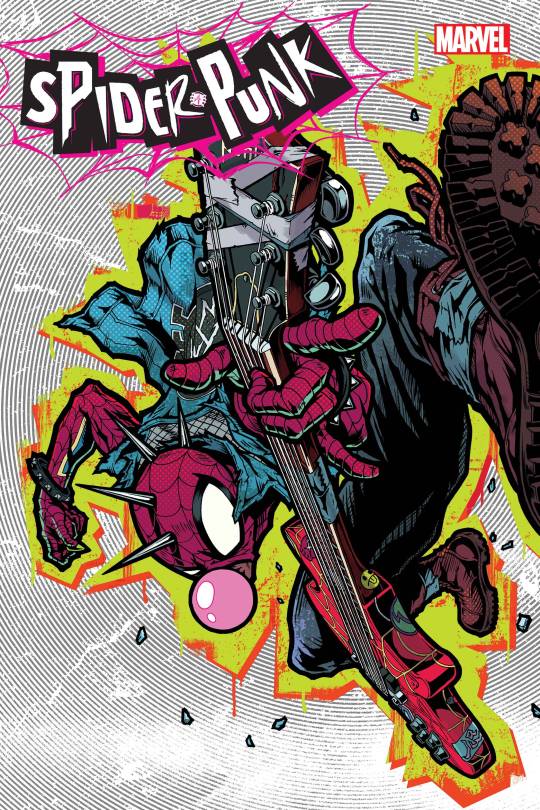
Spider-Punk (2024) #1 cover art by Takashi Okazaki, with writer, Cody Ziglar, and series artist, Justin Mason
This new volume will be a four-issue miniseries that explores what happens when Hobie goes up against the combined might of Justin Hammer and Doctor Octopus. Here's Marvel's official description for the series:
In a world without NORMAN OSBORN, SPIDER-PUNK REIGNS! This ain't no victory lap though – as HOBIE BROWN and team try to rebuild society, JUSTIN HAMMER & DOCTOR OTTO OCTAVIUS have other plans... like introducing the world to the SPIDER-SLAYING SENTINELS! Cody Ziglar (MILES MORALES: SPIDER-MAN) & Justin Mason (SPIDER-MAN 2099: DARK GENESIS) reunite to bring the Brooklyn boy back with the whole crew you know and love! Grab your boots, your instruments, your amps and LET'S GO!
#marvel comics#spiderman#Spider-Man#Spider-Punk#Spider Punk#SpiderPunk#hobie brown#Earth-138#Earth 138#e138
2K notes
·
View notes
Text
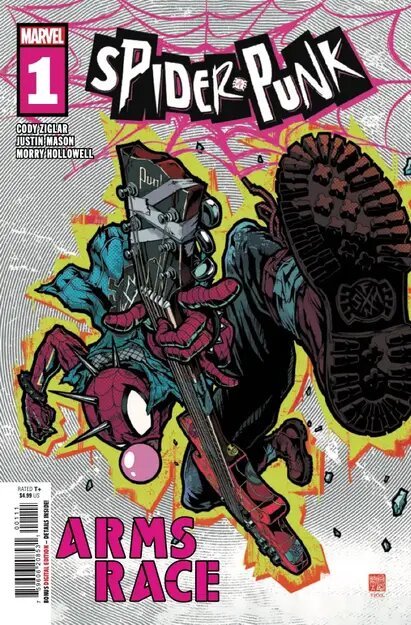
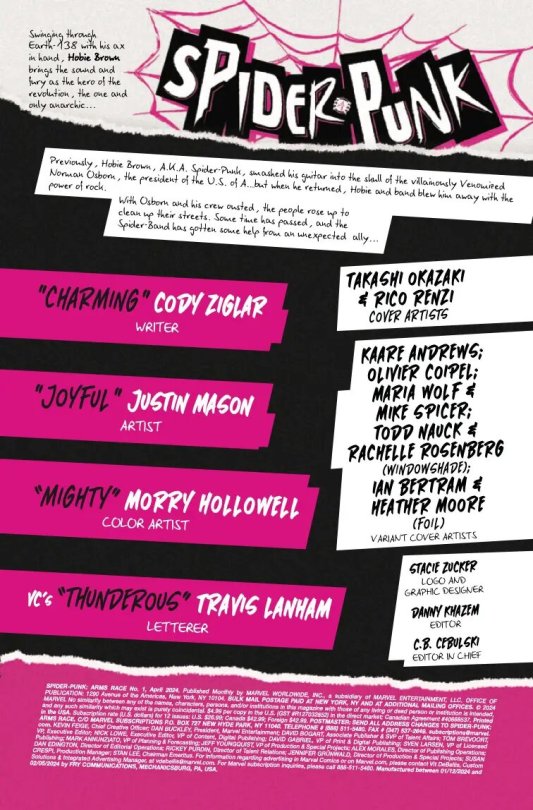
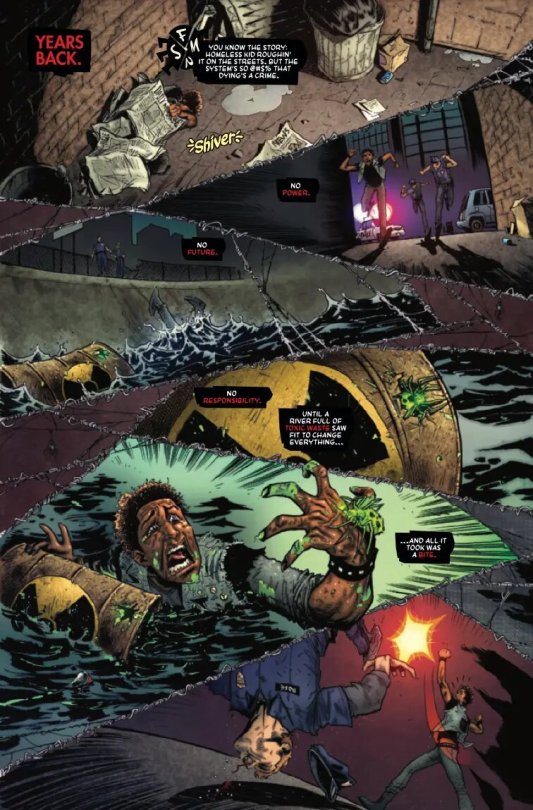



A preview of Spider-Punk: Arms Race #1
SPIDER-PUNK: ARMS RACE #1
ENCORE! YOU WANTED MORE! In a world without NORMAN OSBORN, SPIDER-PUNK REIGNS! This ain’t no victory lap though—as HOBIE BROWN and team try to rebuild society, JUSTIN HAMMER & DOCTOR OTTO OCTAVIUS have other plans…like introducing the world to the SPIDER-SLAYING SENTINELS! Cody Ziglar (MILES MORALES: SPIDER-MAN) & Justin Mason (SPIDER-MAN 2099: DARK GENESIS) reunite to bring the Brooklyn boy back with the whole crew you know and love! Grab your boots, your instruments, your amps and LET’S GO!
Written by: Cody Ziglar
Art by: Justin Mason
Cover by: Takashi Okazaki
Page Count: 40 Pages
Release Date: February 28, 2024
#Spider Punk#anarchic spider man#Hobie Brown#hobart brown#Riotheart#Riri Williams#Mz Marvel#Kamala Khan#Daredevil#Mattea Murdock#Captain Anarchy#Karl Morningdew#Lizard#Curt Connors#Stegron#Vincent Stegron#marvel preview#marvel
171 notes
·
View notes
Note
gib list of problematic books now 🔫
augh im being held at gunpoint omg
okok so theres The Green Mile, which is less problematic but I've gotten ✨comments✨ including but not limited to: "why would you read that it's so violent??" "oh man the movie was bad enough" "really? I thought when you said you liked to read you liked fantasy"
lots of stuff by kyoko okazaki, manga, usually quick reads but hard hitting
another manga artist, moyoco anno, one of her books that i was reading the other day
other than that, i havent read much but i havent been reading much of anything besides that lately
3 notes
·
View notes
Text

SPIDER-PUNK #1 (OF 4)
CODY ZIGLAR (W) • JUSTIN MASON (A) • COVER BY TAKASHI OKAZAKI
VARIANT COVER BY MARIA WOLF • VARIANT COVER BY OLIVIER COIPEL
WINDOWSHADES VARIANT COVER BY Todd Nauck • FOIL VARIANT COVER ALSO AVAILABLE
ENCORE! YOU WANTED MORE!
• In a world without NORMAN OSBORN, SPIDER-PUNK REIGNS!
• This ain't no victory lap though – as HOBIE BROWN and team try to rebuild society, JUSTIN HAMMER & DOCTOR OTTO OCTAVIUS have other plans…like introducing the world to the SPIDER-SLAYING SENTINELS!
• Cody Ziglar (MILES MORALES: SPIDER-MAN) & Justin Mason (SPIDER-MAN 2099: DARK GENESIS) reunite to bring the Brooklyn boy back with the whole crew you know and love!
• Grab your boots, your instruments, your amps and LET'S GO!
40 PGS./Rated T+ …$4.99
4 notes
·
View notes
Text
Spider-Punk Is Getting a New Series in 2024

The new volume of Spider-Punk reunites the creative team from 2022's Spider-Punk: Battle of the Banned - writer Cody Ziglar and artist Justin Mason. The series also features cover art from Takashi Okazaki.
the next chapter in the story of Earth-138’s Hobie Brown kicks off in February. Ziglar and Mason previously teamed for the character’s very first solo series, which ran for five issues in 2022. The duo’s new series promises to pit Spider-Punk and his friends against “a few familiar villains who want society to sing a different tune.”
The new volume of Spider-Punk is a four-issue limtied series that explores what happens when Hobie goes up against the combined might of Justin Hammer and Doctor Octopus. Here's Marvel's official description for the series:
In a world without NORMAN OSBORN, SPIDER-PUNK REIGNS! This ain't no victory lap though – as HOBIE BROWN and team try to rebuild society, JUSTIN HAMMER & DOCTOR OTTO OCTAVIUS have other plans... like introducing the world to the SPIDER-SLAYING SENTINELS! Cody Ziglar (MILES MORALES: SPIDER-MAN) & Justin Mason (SPIDER-MAN 2099: DARK GENESIS) reunite to bring the Brooklyn boy back with the whole crew you know and love! Grab your boots, your instruments, your amps and LET'S GO!
Spider-Punk #1 will debut in February 2024.

Read the full article
2 notes
·
View notes
Text
Sophie Dickman and the Shortish Jewellery Expert
7th July 1985: Sophie Dickman was raped and burgled in Monterey Park.
The Night Stalker underwent one of his many metamorphoses in this case. After this attack, he also dropped his gun before driving off to commit murder a mile away, for the 7th of July was also the night he bludgeoned and strangled Joyce Nelson to death. Perhaps it was the other way round and after the murder – in which Joyce died fighting her assailant – he had a bath, patched himself up and picked up a gun on the way. In any case, Sophie Dickman did not report that her attacker was covered in blood or looked like he had been injured.
Sophie Dickman’s neighbour across the street was Linda Arthur, an LA County crime scene analyst, which was pretty handy (she was featured in the Netflix documentary). Linda Arthur was a friend of Detective Gil Carrillo and one of the few investigators that believed in his madcap serial killer hypothesis, so she decided – for reasons she did not care to explain – that this crime was somehow to do with Gil’s killer and called him in.
This makes no sense – before the Dickman incident, there had only been one rape attack – Carol Kyle’s – which was not yet linked to the Night Stalker attacks and it was not in the San Gabriel Valley. The previous attacks were very different: Dayle Okazaki, Maria Hernandez and Tsai-Lian Yu had been shot in hitman-style attacks. The Zazzaras had been brutally murdered, William Doi had been shot and burgled and Mary Cannon, Whitney Bennett and Joyce Nelson had all been beaten over the head and strangled. Why on earth would anyone connect the rape (and survival) of an older lady with any of those? Bell and Lang had also not yet been connected to the others and were an open case at this point, but their hammer attack did not match Dickman’s either.
This is the composite drawing dated 7th July by the press.
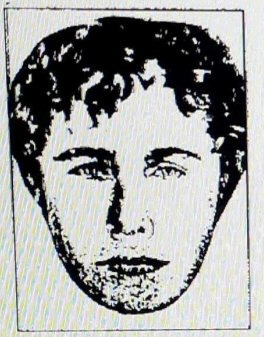
This is silly – composite sketches are not always drawn by artists, so this same face, aside from a few differences has been used in the 1978 suspected Golden State Killer attack (below, centre) and also for the ‘Brayman Road Attacker’ in Connecticut from 1988. Frankly, it should be thrown in the bin.
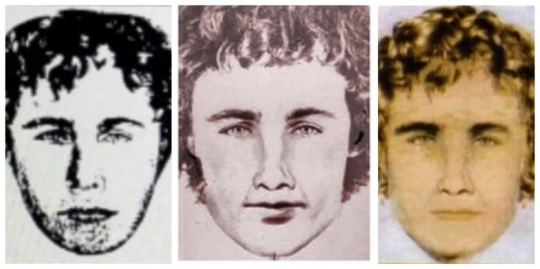
When Evil Triplets Attack
Sophie identified someone from a photo line-up who later went on to be convicted of murder, and he gave up samples of saliva, blood and hair. Because the rape was ultimately unsuccessful (she was sexually injured, but the attacker was impotent), there was no semen to be tested. Therefore, there is no evidence that Richard raped her.
At trial, Sophie Dickman denied that she had told the composite person (we can hardly call them an artist) that the rapist was around 5’8”. She said he had made a mistake and she had in fact, seen someone who was Richard’s height. She also said his hair was medium-length. Richard’s was short in 1985.

However, that becomes less plausible when we discover that she also said he was 5’8” in her initial report. Either both officers are wrong, or she has changed her testimony after media influence.

The latter is more likely, for she admitted to seeing Richard on television multiple times a day, and in the papers.
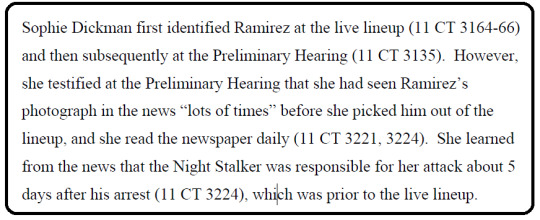
Sadly for Richard, the defence did briefly mention that her description did not match his appearance, but they did not adequately emphasise it to the jury. From the Petition:
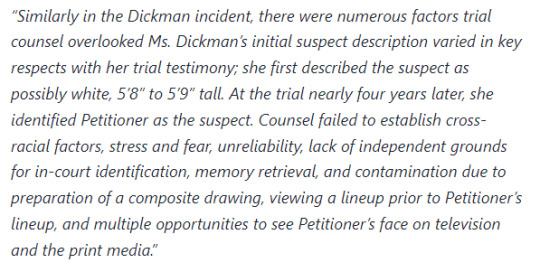
But here is something else to put Richard’s guilt into doubt: we are not privy to the trial transcripts, so, unfortunately, we have to rely on the LA Times. Yes, papers sensationalise stories, but this is all we currently have. Sophie Dickman claimed that the rapist was knowledgeable about jewellery and could differentiate between real diamonds and cubic zirconia on sight.

This is in direct contradiction to what Sandra Hotchkiss, a convicted felon who committed many robberies with Richard said:



So, while Sophie Dickman was raped by a thin man with dark, wavy/curly hair, he was too short, too Caucasian and too knowledgeable about jewellery to be Richard Ramirez.
In the near future, we will compare and contrast the rape-burglary incidents to see if there was sufficient modus operandi to indicate Richard’s guilt.
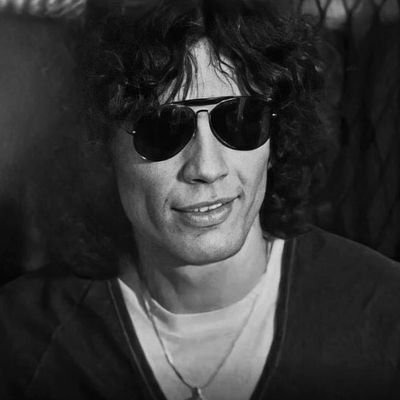
-VenningB-
Full article
#the railroading of richard ramirez#night stalker: the hunt for a killer#night stalker the hunt for a serial killer#netflix#gil carrillo#sophie dickman#police sketch#richard ramirez police sketch#ricardo ramirez#richard ramirez#the night stalker#night stalker#true crime#true crime community#tcc#serial killer
8 notes
·
View notes
Text
Miguel Zenon GOLDEN CITY
MIGUEL ZENÓN
GOLDEN CITY
Miel Music
Miguel Zenón, alto saxophone/composer; Matt Mitchell, piano; Chris Tordini, bass; Dan Weiss, drums; Miles Okazaki, guitar; Daniel Diaz, congas/tripandero/percussion; Diego Urcola, trumpet/valve trombone; Alan Ferber, trombone; Jacob Garchik, tuba/trombone.
Miguel Zenón wanted this music to be a sweeping suite that musically represented the demographics and…
0 notes
Text
Listed: Insomnia Brass Band

Photo by Frank Schindelbeck
The Insomnia Brass Band — made up of trombonist Anke Lucks, baritone saxophonist Almut Schlichting and drummer Christian Marien — was founded in spring 2017 and spent the next several pre-pandemic years on the road at jazz clubs and festivals. Their recorded debut, Late Night Kitchen, out near the end of 2020, was raucous, irresistible and bursting from its seams; it is hard to believe that it required only three musicians. In her review, Jennifer Kelly wrote, “Insomnia Brass Band sounds like a cubist painting of an oompah band, noses jutting off in every direction, cerebral and off-beat, yet somehow capturing an eccentric, unexpected groove.” The band’s sax player, Almut Schlichting, contributed this listed.
Bloor (now Bloar) — “Bast” from Drolleries (Astral Spirits)
youtube
This record invariably calms me down, it is so wild and screaming and so clear and concise at the same time. Right now, it seems like a dream — One dark Berlin winter night in 2019, I rode my bike down the hill to a small place full of friends and musicians, listening to wonderful sets of improvised and composed music spun around Ken Vandermark’s New Marker band, and talking and drinking beer in between... and their drummer Phil Sudderberg recommended his Brooklyn friends, Sam Weinberg’s band Bloor (now Bloar). We hope these situations will soon be real again. Meanwhile, Dusted is not the worst digital place to spend a dark winter night in 2021.
Miles Okazaki — “Misterioso” from Work (Complete, Volumes 1-6)
Work (Complete, Volumes 1-6) by Miles Okazaki
To me, this is Monkish in a double sense of the word — Okazaki shines through Thelonious Monk’s work in a deep and thorough way; but he also seems to be a medieval Monk himself — severe, concentrated, meditative, playing the solo guitar, a clear sound, in transparent magnetic rhythmic layers, in the early morning abbey garden...
Elza Soares — “Luz Vermelha” from A mulher do fim do mundo
The Woman At The End Of The World (A Mulher Do Fim Do Mundo) by Elza Soares
Who else wants to sound like Elza Soares when they are old? No matter if singer or instrumentalist? Moreover, the band and arrangements are amazing, the detailed care with which the sound is built... I love listening to this on headphones while taking a midnight walk across empty streets.
Sons of Kemet — “In The Castle Of My Skin” from Lest We Forget What We Came Here To Do (Naim Jazz)
Lest We Forget What We Came Here To Do by Sons Of Kemet
Grooves in cycles and cycles in grooves, the music is sparse and focused and fascinating, driven by the tenor saxophone of Shabaka Hutchings, who in turn is carried through the song by the tuba and the two drummers. I listened to this album a lot before our Insomnia Brass Band studio session in January 2020. Like most of the tracks chosen here, it resonates with my growing wish to fall into an intense rhythmic trance, repetitions welcome, no matter if listening or playing myself...
Frank Rosaly’s ¡Todos de Pie! — “Cantares de la Sierra (Yaguaré)”
Frank Rosaly's ¡Todos de Pie! by Frank Rosaly's ¡Todos de Pie!
Discovered thanks to Rigobert Dittmann’s great little magazine Bad Alchemy — Drummer Frank Rosaly and vocalist Jaap Blonk go back and forth between abstract landscapes and the carnival with a fat band, combining underwater-like weirdness and a Puerto Rican All Star attitude!
Tom Waits — “Clap Hands” from Rain Dogs (Island Records)
youtube
Tom Waits and this record are very old friends of mine, fueling the addiction to tell bizarre stories in songs, each song carelessly-carefully arranged to become a dark few-minute-fairytale...
Charles Brackeen — Rhythm X (Strata East)
youtube
An old recording, a new discovery — my current online jazz history class is New-York-based trumpet player Thomas Heberer’s Facebook stream, where he is sharing his giant record collection little by little under the simple heading “from the ongoing series of recordings that I love.” Adding to my thousand projects for next week — listen to every record Ed Blackwell and Charlie Haden made together; finally find out more about Don Cherry; and get to know Charles Brackeen at all...
Konono No1 — “Kin 78 One” from Kinshasa 1978 (Crammed Discs)
Kinshasa 1978 by Konono N°1
Another track featuring masters of cycles and grooves, grooves and cycles, the music very vivid and animated through minimal but infinite variations – apparently one of the first recordings of “Congotronics,” presented by the wonderful label Crammed Discs.
Danyèl Waro — “Plantèr” from Gafourn (Piros)
youtube
Since the first Corona lockdown in March 2020, I have been doing improvised late night dance sessions in my kitchen— and the music of Danyèl Waro, Maloya from far away La Réunion, is among my favorite dance partners, as well as the London band Melt Yourself Down, and the old acquaintances Celia Cruz and the Beastie Boys...
Nils Wogram Root 70 — “Hot Summer Blues” from Listen To Your Woman (nWog Records)
Listen to Your Woman by Nils Wogram Root 70
A great band. A great band, has been for years, playing brilliantly and radiating warmth and companionship on this record... according to the liner notes, they had been on the road just before recording this album on a Berlin winter night in 2010, doing what we are all dreaming of right now — travelling and playing and travelling and playing and travelling and playing and really being together again!
#dusted magazine#listed#insomnia brass band#Almut Schlichting#bloor#bloar#miles okazaki#elza soares#sons of kemet#frank rosaly#jaap blonk#tom waits#charles brackeen#konono no1#danyèl waro#nils wogram root 70
4 notes
·
View notes
Video
youtube
Miles Okazaki, Solo Guitar
‘The Complete Compositions of Thelonious Monk’
‘Off Minor’ (WORK, Vol. 5, Track 2, 2018
https://okazakiwork.bandcamp.com/album/work-complete-volumes-1-6
2 notes
·
View notes
Text
Fred Frith - John Scofield - Miles Okazaki: Guitarristas. Por Pachi Tapiz. HDO 548 [Podcast de jazz]
Fred Frith – John Scofield – Miles Okazaki: Guitarristas. Por Pachi Tapiz. HDO 548 [Podcast de jazz]
En HDO volvemos a parte de su dinámica habitual centrando la entrega 548 en tres grabaciones lideradas por guitarristas, las tres más que recomendables.
John Scofield acaba de publicar en el sello ECM Solo, armado únicamente con su guitarra eléctrica y sus loopers, para dar cuenta de un repertorio tanto ajeno (jazzístico y no jazzístico), como propio.
Miles Okazaki lidera un cuarteto que…

View On WordPress
#Anthony Tidd#ECM#Fred Frith#Fred Frith Trio#HDO#Intakt#Jason Hoopes#John Scofield#Jordan Glenn#Lotte Anker#Matt Mitchell#Miles Okazaki#Pachi Tapiz#Pi Recordings#podcast de jazz#Sean Rickman#Susana Santos Silva
0 notes
Text
Thisness album review @ All About Jazz
Thisness album review @ All About Jazz
By Troy Dostert
May 4, 2022
Sign in to view read count
A guitarist as freakishly talented as Miles Okazaki demands a listener’s full attention. This is the case whether one is parsing his fiendishly complex compositions, or beholding his astonishing technique, or simply taking in all the shifting meters and grooves that permeate his music. From the remarkably ambitious Work (Volumes 1-6), his…

View On WordPress
0 notes
Video
youtube
02.25.18 Sadly tonight was the final night at John Zorn's club The Stone on Avenue C. It ended with a killer improv night featuring Ches Smith, Simon Hanes, Will Greene, Kenny Wollesen, Jeremiah Cymerman, Maria Grand, Taylor Levine, Miles Okazaki,Sam Kulik, Chris Dingman and Aaron Edgcomb, and of course Zorn himself. I feel emotional about the closing of this space, where I have spent countless hours hearing amazing music, as well as playing and curating there myself. The Stone will now operate from The New School Glass Box Theater with concerts Tuesday through Saturday nights at 8:30 PM.
#John Zorn#The Stone#Ches Smith#Simon Hanes#Will Greene#Kenny Wollesen#Jeremiah Cymerman#Maria Grand#Taylor Levine#Miles Okazaki#Sam Kulik#Chris Dingman#Aaron Edgcomb#he New School
5 notes
·
View notes
Video
youtube
#1476
Mary Halvorson Quartet - Chaskiel
“Paimon (Book of Angels #32)”
New Book of Angels release! With Mary Halvorson! What’s not to like?
Drew Gress: Bass
Tomas Fujiwara: Drums
Mary Halvorson: Guitar
Miles Okazaki: Guitar
#avant jazz#free jazz#jazz#klezmer#fuckyeahmotorik#motorik#Tzadik#John Zorn#Mary Halvorson#Mary Halvorson Quartet#Tomas Fujiwara#Drew Gress#Miles Okazaki
1 note
·
View note
Text
Sphericity
youtube
Thelonious Sphere Monk probably did not drink as much bourbon as William Faulkner. He probably did not shoot as much heroin as William Burroughs, or smoke as much marijuana as Norman Mailer, or get as many “vitamin shots” from feel-good Manhattan doctors as John F. Kennedy. But he had his share. He had his measure. And the wonder is perhaps, not that he died so young, but that he lived so long. Born in 1917, Monk outlived many of his contemporaries, like Charlie Parker, Fats Navarro, Serge Chaloff, and John Coltrane, dying in 1982, though spending the better part of the last decade of his life in deep emotional and physical decline.
Nine years ago (nine long years) Robin D. G. Kelley wrote Thelonious Monk The Life and Times of an American Original, one of the best books on jazz that I’ve ever read.1 At the time, I conceived a plan to write a long (or longish) piece on Monk, but I was, naturally, distracted, not perhaps from distraction but by distraction, for quite some time. Last year, 2018, proved to be a very auspicious year for Monk fans, and for myself in particular, first of all because I learned of a fascinating project that I could have/should have learned about long ago, the commissioning of 21 contemporary composers by Italian pianist Emanuele Arciuli to create compositions inspired by Monk’s most famous tune, Round Midnight. I posted a video of Spanish pianist Ricardo Descalzo playing the longest of these, “Eine Kleine Mitternacht Musik”, a nine-part suite/“rumination” by George Crumb.2
Equally exciting (if not more so) was the release in 2018 of two complete sets of all of Monk’s compositions, one an extraordinary solo triumph by guitarist Miles Okazaki, called simply Work, available from his own website and the other, equally impressive, from a group led by pianist Frank Kimbrough, Monk’s Dreams. So if the whole world wasn’t telling me to get my act together and write that Monk piece, enough of it was for me to get the hint.
Naturally, my first impulse, after reading Kelley’s book, was to complain about all that Kelley left out! Yes, critics are ridiculous parasites, with all the dignity of a horse fly. If only authors had tails to swat them!
Anyone who is familiar with, and appreciative of, all of jazz (a dwindling few, I am sure) must be struck by the similarities, and the differences, between Monk and the other great “contrarian” of jazz, Lester Young. Just as Monk went out of his way to be the opposite of all the boppers on the scene in the forties, Young went out of his way to be as unlike as possible as the greatest saxophonist on the scene in the thirties, Coleman Hawkins. Both Monk and Young began their recording careers quite late (27 for both), yet both were, among musicians, already famous. Young in particular managed to have an extraordinary reputation even though he was largely based in Kansas City rather than the Big Apple. While still unrecorded, Young was invited to fill the most famous sax chair in all of jazz, that of Coleman Hawkins himself, with the Fletcher Henderson band, even though Young’s style was the precise opposite of Hawkins’.3
But the differences are significant as well. Young did not record with the Henderson band, making his first recordings with a small group drawn from the Basie band, which he joined in 1935. Young’s solos on “Shoeshine Boy” and “Lady Be Good” are among his very best, and among the very best in all of jazz.
Monk’s first recorded solos, in 1943 with a small group led by Coleman Hawkins, are, in contrast, entirely unremarkable, and even his first recordings under his own name, in 1947, sound awkward, though that may be more the fault of the band than Monk. It isn’t until the next year, in the session with Milt Jackson that produced the first recordings of both “Misterioso” and “Evidence”, that we begin to hear the “real” Thelonious, and the “real” Thelonious doesn’t emerge in quantity until 1951, when he recorded with Jackson again.
Yet Monk was already “famous” among the musicians of New York. He was mentor to Bud Powell, who became the first famous bop pianist, even though Monk was seven years older and had been the house pianist at Minton’s, the Harlem night club forever famous as ground zero of the bop revolution. Powell instantly realized, as Monk refused to do, that the way to become famous in the bop scene was to become “the Charlie Parker of the piano” (or whatever instrument one played).
Monk, of course, was not interested in being the Charlie Parker of the piano. He wanted to be the Thelonious Monk of the piano, which he already was, so, in effect, his work was complete. He expected the world to come to him and, when it did come to him, to accept him as the genius he indubitably was.4 He disdained entirely the cult of virtuosity, the surest ticket to recognition for any musician, and the virtuosity of the early boppers—the early famous boppers, like Parker, and Dizzy Gillespie, and Bud Powell—was legendary.
Charlie Parker was, of course, Monk’s great rival. While Parker was alive, at least, Monk’s attitude seems to have one of jealousy, that Parker was getting credit for all of Monk’s innovations. The contrasts between the careers of the two men could scarcely have been more complete. Parker, starting out in Kansas City, like Young, was a featured soloist with Jay McShann’s “territory” band (i.e., not nationally recognized) at age 18. At age 20, in a private recording session, he produced two brilliant solos on two tunes closely associated with Lester, “Honeysuckle Rose” and “Lady Be Good”, sounding very much like Lester on the alto. By age 25, Parker had made some of the most important records in jazz.
Still, Monk had his chances. Despite their rivalry—for Monk felt that Gillespie had “stolen” from him as well—Monk took the job as pianist in Dizzy Gillespie big band, formed in 1945 (live recordings of the band exist, available on the CD Dizzy Gillespie Showtime at the Spotlite, though Monk is rarely featured). In true Monkish fashion, he messed everything up, almost invariably skipping the first set of each performance, a “habit” that persisted even for the most important date of his life, the legendary engagement at the Five Spot Café with John Coltrane in 1958.5
Monk was replaced with John Lewis, who had all the discipline Monk lacked, though little of his genius, and who took the opportunity to employ three of his bandmates–Milt Jackson (vibes), Ray Brown (bass), and Kenny Clarke (drums), all three the leading bop musicians on their instruments–to form what was originally called the Milt Jackson Quartet, later morphing into the famous Modern Jazz Quartet, a group that could have been Monk’s.
Monk’s suspicions and resentments plagued him throughout his career. He was almost always on bad terms with his labels, first Blue Note and then Prestige. Blue Note was probably just disappointed in the poor sales of his records, but Prestige seems to have been actively trying to push Monk off the label, frequently using him as a sideman. Yet, again, Monk himself often didn’t seem to be paying attention. He recorded one of his most striking works, an elaborate arrangement of Jerome Kerns’ “Smoke Gets In Your Eyes” for Prestige, an almost guaranteed crowd pleaser, yet never, so far as I am aware, performed it live or ever recorded it again. In the famous Dec. 24, 1954 session led by Miles Davis, he recorded his legendary solo on the Milt Jackson composition “Bag’s Groove”, which he thereafter consciously excluded from his repertoire.
Even when Monk signed with Riverside Records, teaming him with a producer, Orrin Keepnews, convinced of Monk’s genius and determined to bring Monk the recognition he deserved, there was endless friction. Keepnews believed that the combination of Monk’s unorthodox compositions and his unorthodox piano style was too much for the masses, a theory which he “explained” (probably to excess) in the copious liner notes that were the fashion of the day and which led him to devote Monk’s first two albums to compositions of other composers. The first, a salute to Duke Ellington, was a success, and a fascinating album, for Ellington, unsurprisingly, was one of Monk’s heroes. The second, The Unique Thelonious Monk, devoted to (white) standards, was less successful. When “forced” to play other people’s music, Monk would almost invariably play the melody straight, perform a brief, perfunctory improvisation, and then conclude with random dashes at the keyboard to express his disdain for such trivial fare.
Since Keepnews “wasn’t interested” in his own compositions, Monk took four of them with him when he served as a sideman on a session led by saxophonist Gigi Gryce, which surely irritated Keepnews. When Monk was finally allowed to play his own music by Keepnews, the results were excellent, but the bloom quickly faded from the rose. There were endless delays, failed sessions, and missed dates. Monk was “offended” by the success of other musicians in Riverside’s stable, like pianist Bill Evans and saxophonist “Cannonball” Adderley. The fact that Adderley, an excellent musician and a serious student of jazz, aggressively courted popularity meant nothing to him, nor did he think that Evans’ “exquisite” renditions of Gershwin and other Broadway composers might prove both more accessible and more popular than his own mysterious compositions, not to mention his patented counter-intuitive virtuosity, which consciously discarded everything that appealed to the untutored sensibility.
Despite a large number of classic recordings, by 1960 Monk had lost interest in working with Riverside, providing, to Keepnews’ increasing frustration, nothing but “live” recordings, using the same format over and over again, a quartet featuring the always excellent Charlie Rouse as the only other solo voice, a format that, in fact, Monk retained for the rest of his career.
By the early 60s, Monk was far more famous than he had ever been, recording with one of the biggest labels in the country, Columbia. He put a great deal of effort into his first album for Columbia, Monk’s Dream. Like many jazz musicians, Monk very often insisted on “first take, best take,”6 but on Monk’s Dream he was willing to pursue as many as eight. Thereafter, however, his energy declined. Throughout his years with Columbia, he refused to take any advantage of the many opportunities his long-delayed fame offered him, clinging to the same performing format and repertoire and very rarely offering any new compositions. His passivity was such that he even complied with Columbia’s insistence on a big band album, Who’s Afraid of the Big Band Monk?, with utterly abysmal arrangements by a totally clueless Oliver Nelson. It’s more than painful to hear Monk striving against Nelson’s syrupy settings, even worse than the “Parker with Strings” and “Parker With Voices” albums cooked up for Charlie Parker by the well-meaning (but stupid) Norman Granz for the great Bird.7 Yet even here Monk managed to wrest greatness from the wreckage: his solo on “Brilliant Corners”, the famously “impossible” tune that he never recorded after its premiere on the Riverside album of the same name,8 is magnificent.
Many years ago, I heard Charlie Mingus say in an interview that Monk and Duke Ellington were the only two “compers” (accompanists) he admired.9 Every other pianist in jazz, Mingus said, simply played the same chords over and over. Only Ellington and Monk showed thought in their accompaniment, only they understood that a solo is supposed to show development. But the differences between Ellington and Monk are, if anything, even more pronounced than their similarities. Ellington was fascinated by listening to his soloists, understanding their capabilities and sensibilities–which he understood better than they did–and leading them where in effect they wanted to go, bringing out the best in them in harmony with his own overarching conceptions.
Monk, in contrast, played the accompaniment that his soloists ought to have wanted, if they had Monk’s sensibility. Not only did Monk want what he wanted, he never bothered to explain what it was he wanted, and he frequently changed his mind. Monk wanted everything to happen both the way he wanted it and of its own accord.
Monk composed a mere handful of pieces, somewhere between 70 and 75, depending on how you count them, while Ellington wrote over 1,000. At the same time that Monk was struggling to be recorded, “establishment” composers like Irving Babbitt and Ned Rorem received massive subsidies and prestigious critical recognition. Yet Amazon lists over a hundred albums each for Babbitt and Rorem, but over a thousand for Monk, an unfair comparison indeed, but one I’ll make nonetheless.10 Many of Monk’s compositions were reworkings of popular tunes of little consequence, yet almost fifty years after his death his reputation seems to grow with each passing year, and recordings of his work are almost without number. The wind bloweth where it listeth.
Afterwords
Hundred of jazz videos, most of them performances of Monk’s tunes, are available from my website here. “Mostly Monk” has hundreds more and is a wonderful source. Ten years ago I wrote a piece about “Salute to Thelonious” albums, discussing about 30 of them. A few years later I added four more but then gave up, a little overwhelmed. I also reviewed The Jazz Baroness, a documentary on the life of jazz patron Pannonica de Koenigswarter, who cared for Monk during his last years, for the Bright Lights Film Journal.
Another is Scott DeVeaux’s Bebop A Social and Musical History, a near-microscopic study of developments in jazz from about 1940 through 1945, published in 1997. ↩︎
You can get an album from Amazon, ’Round Midnight, of Arciuli playing all of the variations except Crumb’s, and you can get Arciuli playing “Eine Kleine Mitternacht Musik” on another album, Complete Crumb Edition 9; Ancient Voices of Children, Madrigals Books I-IV, Eine Kleine Mitternachtmusik. (I say “album” instead of “CD” because it’s a lot cheaper to download these.) ↩︎
Young’s first influence, apparently, was Frankie Traumbauer, a white musician who played a very obscure instrument, the C-melody sax, falling mid-way in size between an alto and tenor. Trambauer’s “fame” was closely tied to that of once-legendary cornetist Bix Beiderbecke, who is still something of a name (go here to download his music). ↩︎
Monk often refused to answer interviewers’ questions. Why speak with ignorant people? Yet with musicians he trusted, he could be compulsively, though no doubt elliptically, voluble, in conversations that ran all through the night. ↩︎
Live footage of this session exists, though unfortunately you won’t find it on YouTube. Multiple ironies are involved. In 1957, Monk appeared on a CBS special “The Sound of Jazz” (available on YouTube, with the Monk footage mysteriously deleted). In 1958, CBS did another special, on “Youth”, and took their cameras to the Five Spot. No one associated with the production seemed to have the least idea of who Monk or Coltrane was. The Five Spot was apparently chosen because that’s where “the kids” were going. The kids, in this case, were Ivy Leaguers, the guys in suits and the Seven Sisters gals in little black dresses and pearls, all of them smoking and drinking up a storm, while the “adult” narrator talks all over the great music we’re hearing, absolutely bewildered as to how or why anyone could or should listen to such “noise”. I saw this footage in a Monk documentary, probably The Jazz Baroness, about Monk’s patron (one of them, at least), Pannonica de Koenigswarter, which I reviewed here ↩︎
However, this was not always the case. The CD reissue of the great Riverside solo album, Thelonious Himself, features a 25-minute cut of Monk struggling to get “Round Midnight” to come out the way it ought to. ↩︎
These hopeless monsters—arrangements of standards whose chord changes, in many cases, served as the basis for Parker’s own compositions—are, at least, “funny” (for those possessing unusually jaundiced sensibilities), particularly the “voices” album, as Parker, who adopts a “golden’ tone for the occasion (the “real” Parker always played sharp), swoops and swirls his way around the pathetically square arrangements. But Oliver Nelson was desecrating not Gershwin but Monk, and it’s far too ugly to laugh. ↩︎
According to the liner notes of the latest reissues of this classic album, most of the musicians on the date found the tune incomprehensible. Monk, in classic Monk fashion, refused to offer any explanation, simply yelling at them whenever they got it “wrong”. After hours of takes and retakes (and yelling), Keepnews had to splice together two takes to produce what’s heard on the album. Now, of course, there are any number of excellent performances available. ↩︎
Dizzy Gillespie said that Ellington was “the best comper ever.” ↩︎
I am no judge of “establishment” music, whatever that is, but I’ve listened to several albums of Rorem’s “songs”—musical settings of classic poems like Frost’s “Stopping by the Woods on a Snowy Evening”—and felt the music only distracted from the poetry. However, I am very much indebted to Rorem for a very odd reason. His diaries, which began to be published sometime in the late sixties (I believe) gave most of us straights our first peek into the swinging life of a gay man about town, enjoying all the pleasures that Paris had to offer, anonymous sex in particular. The diaries prompted the funniest parody I ever read, appearing in the New Yorker. I’ve forgotten the author’s name, but I haven’t forgotten the following passage: “Happened to run into X, who told me I’m the handsomest man alive. Catching sight of myself in a store window, I had to agree. How often are beauty and genius allied! How they will hate me when they read this, and I only speak the truth! How few can say as much!” ↩︎
1 note
·
View note